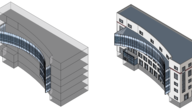Autodesk Software Used:
Project Goals
About the design competition
The Transformation 2030 design competition challenged students to design a large mixed use development at the site of a former juvenile detention center in the South Bronx of New York City. The building program includes residential apartments, a nursery school, a fresh foods grocer, an office space, and a performing arts space, an event center, and a commercial kitchen.
Phase 1 of the competition is a conceptual design of the overall site, and Phase 2 dives deeper into the design of the event and culinary center.
See a write-up on all of the finalists.
Design Process
Starting with Climate Data to Choose Design Strategies
The first thing the designer did to help select high performance building design strategies was analyze climate data.
The psychrometric chart above from Ecotect’s Weather Tool shows that taking advantage of passive solar heating, natural ventilation, and thermal mass effects are the passive strategies that are most likely to most improve human thermal comfort.
Taking advantage of natural ventilation and passive solar heating, as the climate analysis suggested, would require using the building’s massing and orientation to harness the available sun and wind.
The studies above from Autodesk Vasari and Ecotect show that elongating the building in the East-West direction can help optimize both passive cooling (prevailing summer winds strike perpendicular, controlling summer sun) and passive heating (harnessing winter sun).
These studies help guide inform how to most effectively implement strategies from the 2030 Palette (2 swatches shown below).

Iterating Form and Implementing Sustainability Strategies
Based on this initial insight, the designer worked with the massing and orientation of the building program to come-up with a suitable initial design for testing and refinement. The illustrations below document an effective process for fitting programmatic elements onto the site to help meet performance and social goals.
The illustration below shows how the initial proposal was informed by the insights from climate analysis.
Vasari as an Analysis tool to Confirm Design Choices
As building forms were being considered, the designer iteratively tested conceptual massing prototypes in Autodesk Vasari and used the performance results to choose the final design.
The image below shows how the incident solar radiation on a conceptual south façade drops off as the face is oriented away from the south. The designer chose to keep all south facing facades within 30 degrees of south.
Author’s note: No mention was made in the following study about the time period of the analysis (summer vs. winter) and metrics used (average vs. cumulative). This would have made the analysis stronger, as sometimes a lot of incident solar radiation will help improve performance while sometimes it will decrease performance.
A further courtyard study was aided by the energy analysis and solar radiation analysis tools in Vasari. You can see in the image below that the designer was able to experiment with different forms, while keeping an eye on the total floor area, wall area, and energy use intensity.
The potential energy savings chart shown below, an artifact from energy analysis within Vasari, leads to the following conclusions: the thermal properties of windows, walls, and roofs are three of the most important factors that can drive energy efficiency (with roof being relatively more important). This is seen by the size of the overall bars. Furthermore, the material choices that the designer has made are relatively good. This is seen by the portion of the bars that are on the right of the “current model” baseline (in darker blue).
The Design
Site plan and proposal
The designer says that “in pursuit of a carbon neutral future, adaptive re-use may be one of the key tools at our disposal.” Despite the fact that the design brief did not call for re-using the existing juvenile detention center on the building site, this design proposes to re-use it.
This decision to re-use the building was made only after performance studies, explained above, were done to confirm that the orientation and massing of the existing building would support a high performance building. Because the existing structure was likely designed at a time when passive strategies more actively drove the form of buildings, this was found to be the case.
Whether or not re-using the building ultimately proves to be the most cost effective and environmentally friendly solution in the real-world development, the judges appreciated that the designer was forcing this question.
After the decision to re-use the existing structure was made, the building program shifted as shown below.
The simulated EUI of the overall conceptual mass was 61.2 kBTU/sf, which is 15% less than the average Northeast Multi-family building. Additional EUI reductions would be possible by increasing lighting efficiency and decreasing plug loads, options that are not readily available in Vasari’s energy simulation tools.
Event and Culinary Space
The massing of the proposed kitchen and culinary space is a compact cube-like form. One of the reasons why this form was chosen was to make the public spaces around the building more pleasing.
One of the passive design strategies from the 2030 Palette that helped inform the design of the event space was “Indirect Gain: Sunspace.” See the diagram below for a schematic of how the proposed design would conceptually work.
Author’s note: The effectiveness of this design was not tested with simulation, and the thermal interactions shown here are too complex to be effectively captured with the energy analysis of the conceptual mass. CFD analysis would be an effective tool to study this behavior. That said, these diagrams show a solid understanding of how sunspaces can be used to both heat and cool.
This sunspace was designed to help ventilate the building (using waste heat from the kitchen to heat the space when needed) and provide top lighting for the kitchen space. The diagram below shows a detailed section of how this could work.
Quotes from Transformation 2030 judges
“The Hunts Point Revival project successfully demonstrates how environmental analysis can work hand in hand with social, contextual and conceptual considerations to develop a compelling scheme that works on multiple levels.” - Juliane Wolf, StudioGang, Design Principal
“Hunts Point Revival did an excellent job coming up with an exciting proposal that fits the site and neighborhood while seamlessly incorporating the sustainability requirements of the competition. It was a very well thought out design concept.” - Scott Schiamberg, Perkins Eastman
“Hunts Point Revival’s reuse of the existing structure as part of the new development was conceptually bold and challenging. Overall, the project contained a good blend of creative sustainable design elements. The solar room for heating and ventilation was particularly creative and convincing.” - Edward Mazria, Architecture 2030
About the Designer

Maksym Rokhmaniiko did his undergraduate studies at Kiev National University of Construction and Architecture. He did this competition during his Master’s degree at the University of Oregon as a Fulbright Scholar.
On his motivations being an architect: “I got to be interested in architecture, because I viewed it as an opportunity to implement my natural inclination for mathematics and sciences as well as passion for arts. I have set the vector for my career—I want to design, I want to develop ideas that can be of use for as many people as possible.”
| Attachment | Size |
|---|---|
| 19.31 MB |
















